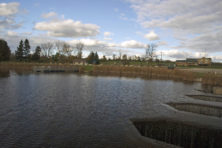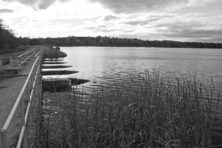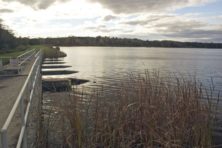Options Presented for Forestville Millpond
- Share
- Tweet
- Pin
- Share
A joint meeting of the Door County Parks Committee and Land Conservation Committee to discuss the Forestville Millpond management was held June 21, too late for this week’s issue. However, the Pulse did obtain a copy of the final report prepared by the Door County Soil and Water Conservation Dept., so we can provide some highlights of the plan, and will report in next week’s issue on what actually took place at the meeting.
The 62-page report, plus appendices, begins with an executive summary that details the history of the millpond, going back to its creation in 1877, stating that “historic accounts illustrate a once healthy, multi-use waterbody. Decades of both anecdotal and scientific observation have begun to document a steady decline of the overall health of the Millpond and has continually been a topic of concern among the public and local officials.”
A survey of the 94-acre Millpond found it to be very shallow, with 92 percent of the water being less than three feet deep. The maximum depth is six feet.
The study also revealed one to two feet of muck at the bottom, representing “a very shallow system with an abundance of unconsolidated sediments that are easily stirred up and contribute to poor water clarity conditions.” Sediment cores revealed high levels of phosphorous, as well as elevated levels of oil and grease. Some samples showed traces of heavy metals, but not enough for concern.
The report states that agriculture takes up 50 percent of the approximately 17,900 surrounding acres, and its testing highlights “the primary driver of pollutant loading as agriculture.”
An aquatic plant survey found little aquatic vegetation other than the invasive Eurasian milfoil, leading the report to state “that changes need to be made to create a sustainable home for a biodiverse population.”
A survey of fish revealed carp to be the most abundant species, and largemouth bass to be the most abundant game fish, but far behind the carp population.
“The makeup of the fish population is characteristic of a eutrophic waterbody with elevated nutrient inputs, low dissolved oxygen levels and plant populations that reflect those conditions.”
The report provides the following management options:
- Do nothing: In this scenario, “It is highly likely that water chemistry and clarity will continue to decline.” But the report also points out that the “Millpond currently functions as a sediment basin; the pooling of the Ahnapee River behind the dam allows sediment to settle out. This is a function which may somewhat improve water quality downstream and reduce the volume of sediment delivered to Lake Michigan.”
- Dredge: “Dredging would be a high cost, high impact alternative.” It could be done on a large scale to reduce vegetation and sediment, or on a smaller scale to create a swimming beach. “A Combination of dredging with some type of drawdown could reduce the costs of sediment removal.”
- Harvest aquatic vegetation: Due to the nature of the millpond, mechanical or chemical treatment would not work, so harvesting by hand is the most feasible method to deal with the Eurasian water milfoil, which the report staes must be greatly reduced to sustain some form of sport fishery.
- Reduce agricultural runoff: “Regardless of the objectives for long-term use of the Forestville Millpond, the Door County SWCD is committed to implementing this management option in the Millpond Watershed, and all watersheds throughout Door County.”
- Develop a lake management district or voluntary lake association: This would provide local residents with great decision making influence and opens another potential source of grant funding for management options.
- Conduct intensive education effort: This goes with option 4 and/or 5, and would likely be implemented by a local civic organization or lake association with technical support from the county and state.
- Remove the dam, eliminate the millpond and return the Ahnapee River to an uninterrupted stream: “This may be the least cost management option for greatest impact,” the report states. “This option would create a dramatic change to the landscape as much of the aquatic habitat would transition to terrestrial or riparian areas.”
- Full-year drawdown of the millpond: This would allow bottom sediments not in the stream channel to compact and crust over. This would also help with the removal of invasive vegetation and the rough fish population. It is a low-cost management option.
- Winter season drawdown: This would have similar impacts to option 8, with the exception of the compaction of sediments. While it won’t be as effective as a year-long drawdown, it might be more acceptable to the local community.
- Reconstruct bottom gates and spillway of dam: Allow excess sediment to flow downstream. This was cited as a costly retrofitting option with negative downstream impacts.



